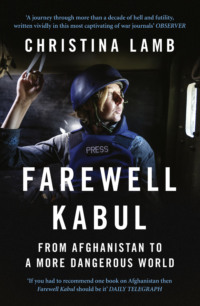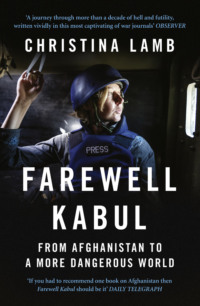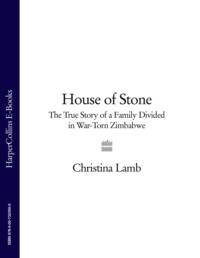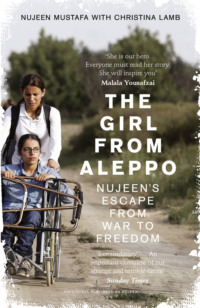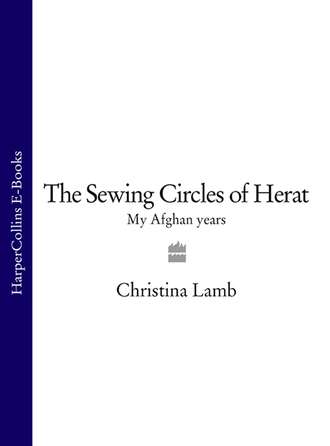
Полная версия
The Sewing Circles of Herat: My Afghan Years
After having taken various ‘resistance tours’ inside from Peshawar, I decided to go to Kandahar largely because I liked the name. Alexander the Great had conquered many peoples and founded a number of cities on his long march from Macedonia towards India, most of which bore some variation of his name. But there was something magical about the name Kan-dahar, which pronounced with the stress on the first syllable and a long breath at the end, seemed to convey a sense of longing for the place.
Kandahar was where everything had started. Under the shimmering turquoise dome that dominates the sand-blown city lies the body of Ahmad Shah Abdali, the young Kandahari warrior who in 1747 became Afghanistan’s first king. The mausoleum is covered in deep blue and white tiles behind a small grove of trees, one of which is said to cure toothache, and is a place of pilgrimage. In front of it is a small mosque with a marble vault containing one of the holiest relics in the Islamic World, a kherqa, the Sacred Cloak of Prophet Mohammed that was given to Ahmad Shah by Murad Beg, the Emir of Bokhara. The Sacred Cloak is kept locked away, taken out only at times of great crisis1 but the mausoleum is open and there is a constant line of men leaving their sandals at the door and shuffling through to marvel at the surprisingly long marble tomb and touch the glass case containing Ahmad Shah’s brass helmet. Before leaving they bend to kiss a length of pink velvet said to be from his robe. It bears the unmistakable scent of jasmine.
In a land of war, the tomb of Ahmad Shah is a peaceful place. Only the men with stumps for legs and burqa-clad war widows begging at its steps hint at the violence and treachery which has stalked Afghanistan since its birth as a nation-state, founded on treasure stolen from a murdered emperor. Part of that treasure was the famous Koh-i-Noor diamond, then said to be worth enough to maintain the whole world for a day and now among the Crown Jewels under twenty-four-hour guard in the Tower of London, stunningly beautiful but blighted by an ancient Hindu curse that the wearer will rule the world but if male will suffer a terrible misfortune.
A member of the war-like Pashtun tribe of Abdalis, Ahmad Shah was commander of the bodyguard of Nadir Shah, the great Persian conqueror who in 1738 had captured Kandahar from the Ghilzai, another Pashtun tribe and traditional rivals of the Abdalis. Nadir Shah moved east to take Jalalabad, Peshawar, Lahore and finally Delhi, where angered by locals throwing stones at him, he ordered a bloodbath in which 20,000 died. He left laden with treasures of the Moghuls including the fabled Peacock Throne of Emperor Shah Jahan, creator of the Taj Mahal, which was solid gold with a canopy held up by twelve emerald pillars, on top of which were two peacocks studded with diamonds, rubies and emeralds. Among the precious jewels he packed on his camels was the Koh-i-Noor, named after his exclamation on first seeing the 186-carat stone, describing it as ‘koh-i-noor!’ or ‘mountain of light’.
After India, Nadir Shah travelled west, conquering as he went, but with the Koh-i-Noor in his turban, he became more and more ruthless, convinced that everyone was trying to kill him, even his favourite son Raza Quli whom he had blinded. One night in 1747, travelling on yet another military campaign, someone stole into Nadir Shah’s tent and stabbed him to death. Ahmad Shah fled the camp with his 4000-strong cavalry and headed to Kandahar, taking much of the emperor’s treasury, including the cursed Koh-i-Noor.
Freed from Persian domination, the Abdalis held a jirga, a tribal assembly of elders and religious leaders to decide on a ruler. After nine days of discussion they settled upon the twenty-five-year-old Ahmad Shah, partly for his charisma, partly because he was a Saddozai, from the tribe’s most distinguished line, partly because a holy man stood up and said he should be, and largely because he had a large army and lots of treasure. A sheaf of wheat was placed on his head as a crown.
Ahmad Shah’s affectation of wearing a pearl earring from the looted Moghul treasures led his subjects to call him Durr-i-Durran, Pearl of Pearls, and the royal family became known as the Durrani clan. He set up a shura or tribal council to govern the country, and, quickly realising that the best way to control Pashtun tribes was to indulge their taste for warfare and plunder, he used Nadir Shah’s booty and a succession of military adventures to keep them in check. Helped by the fact that to the west Persia was in disarray after Nadir Shah’s death, and to the east the Moghul Empire was crumbling, Ahmad Shah ended up carving out the second greatest Muslim empire after the Ottoman Empire, taking Kabul, Peshawar, Attock, Lahore, and eventually Delhi.
Never the most modest of men, he had coins minted with the inscription, ‘the Commandment came down from the peerless Almighty to Ahmad the King: Strike coins of silver and gold from the back of fish to the moon’.
After his successes in India, Ahmad Shah moved west to capture Herat which was still under Persian rule, then north of the Hindu Kush to bring under his control the Hazara of Bamiyan, the Turkmen of Asterabad, the Uzbek of Balkh and Kunduz, and the Tajik of Khanabad and Badakshan to create Afghanistan as it is today. But he had to keep returning to India where his territories were threatened by the Hindu Maratha armies from the south. Invading India for a fourth time, he acquired Kashmir and Sindh.
Yet he always missed his homeland. A deeply religious man and warrior-poet, he wrote of Kandahar:
Whatever countries I conquer in the world I can never forget your beautiful gardens When I remember the summits of your beautiful mountains I forget the splendour of the Delhi throne.
Each time he left Kandahar there were plots to overthrow him, often by his own relatives and whenever he returned home from extending his empire, Ahmad Shah would spend the first few days executing dissidents. A later king, Abdur Rahman Khan, would refer to his country as Yaghistan or Land of the Unruly, and as the great Afghan scholar, the late Louis Dupree remarked, ‘no Pashtun likes to be ruled by another, particularly someone from another tribe, sub-tribe or section’.
In an attempt to deter the pretenders, the king started executing not only the plotters but also ten randomly chosen members of each sub-tribe involved, yet the intrigues continued. A sword wound on his nose turned ulcerous and cancer began eating away at his face, leaving him in terrible pain and according to accounts of the time, forced to wear a silver nose, with maggots from the wound dropping into his mouth whenever he ate or drank. The Sikhs raised an army and rebelled in the Punjab, forcing him to return to India a fifth, sixth, seventh and eighth time, twice destroying the Sikh city of Amritsar in his anger but never really succeeding in defeating them. Other parts of his empire broke away, some declaring independence, while Murad Beg, the Emir of Bokhara, took others.
Despairing of the land he had created, in 1772 he died alone and in agony in the Suleyman Mountains east of Kandahar, aged only fifty. He left thirty-six children including twenty-three sons most of whom thought they should be his successor. From then on the Durranis lost Punjab, Sindh, Kashmir and much of Baluchistan as two Durrani branches, the Barakzai and Saddozai – and family members within – tussled for control. With no outsiders to unite against until the first British invasion in 1839, soon everyone was fighting and blinding everyone else for power in each region, fathers against sons, brother against brother, uncle against nephew and one wearer of the Koh-i-Noor after another met a violent death.2 They even had a name for it – badshahgardi, which means ruler-turning.
But in his heyday Ahmad Shah had ruled an empire stretching from the Amu Darya or Oxus River in the north to the Arabian Sea, from Mashad in the west to Delhi in the east, as well as Kashmir, Sindh and most of what is now Baluchistan. One way or another the Durrani dynasty he founded was to rule Afghanistan till the Communist takeover in 1978 and most Afghans regard him as the father of the nation, referring to him as Ahmad Shah Baba.
There was another reason for wanting to go to Kandahar. In Peshawar I had met a direct descendant of Ahmad Shah Abdali, a Kandahari called Hamid Karzai. Educated at a private school in the Indian hill-station of Simla, followed by a master’s in political science at Delhi University, he was about thirty and spoke the old-fashioned English of newspapers in the subcontinent, addressing women as ‘ma’am’ and using expressions such as ‘turning turtle’ and ‘miscreants’.
Hamid was unlike anyone I had ever met. He wore a leather jacket and jeans, yet walked with the bearing of a king. In a city where men did not consider themselves dressed without rocket-propelled grenades or Kalashnikovs across their shoulders, he was polite and gentle and liked reading English classics such as George Eliot’s The Mill on the Floss. He had a beaked nose and a bald round head that cocked from side to side like a bird as he fixed deep brown eyes upon his listeners. With me he would talk about English music and literature, the feeling that he had lost his youth, and his hatred for Pakistan and his life there. But the greatest passion in his voice came when he spoke of Kandahar with its orchards and running streams, grapes which he said came in forty varieties, not just green and black as I had known in England, and deep-red pomegranates so sweet and luscious that Persian princesses dined on them and lovers wrote poetry about them. He told me too of great tribes and heroic clashes and had a sense of history and being part of it unlike anyone I had ever come across. His eyes would bulge with anger as he talked of centuries-old feuds between his tribe and another.
His tribe were the Popolzai, a Durrani clan that could trace their origins back to the fifteenth century and had given the king the land to build Kandahar as his capital. Once I asked him to tell me their story. ‘It’s too long,’ he laughed, telling me only the part about an Abdali khan who was so old and weak he could no longer mount his horse and beseeched his four sons to help him. The first three all laughed and refused. But the youngest, whose name was Popol, put him on his back and carried him, so when the old man was dying, it was Popol he named as his heir.
Though Hamid was not the eldest of the seven sons of Abdul Ahad Karzai, leader of the Popolzai, he was the only one not to have gone into exile and thus regarded as the probable successor. His brothers all lived in America where they ran a chain of Afghan restaurants called Helmand in Chicago, San Francisco, Boston and Maryland.
He too had been planning to move abroad but after the Soviets took over and imprisoned his father, he abandoned his studies in India to travel to Pakistan and visited a refugee camp near Quetta where he found himself surrounded by hundreds of Popolzai. ‘They thought I could help them just because of who I was,’ he said. ‘But I was who I was only because of them. They were such brave people, it made me feel humble and guilty about my privileged life and I became determined to be the man they thought I was.’
His house in Peshawar bustled with tribal elders, large men with complicated turbans, sitting cross-legged on floor cushions in various rooms, drinking green tea from a pot constantly replenished by a small boy, and unwrapping small silver-foil Hershey Kisses sent by Hamid’s brothers. Some of his visitors looked wild and unwashed and seemed from another century entirely to Hamid, but he listened to them with great respect and gave them food and shelter, while he himself lived very simply, using any money he acquired to help his tribesmen.
‘I’ve always had this drive. It’s something in me, this great love for the tribe,’ he said. Yet growing up he had hated what he called the ‘tribal thing’ and had been eager to escape Kandahar and go abroad. Had the Russians not invaded, his dream had been to become a diplomat, perhaps even Foreign Minister one day, but the war had changed everything. His skill was with words rather than guns so he became spokesman for the National Liberation Front of Professor Sibghatullah Mojadiddi, a royalist from a prominent Sufi family and one of the most moderate – and thus worst funded – of the seven leaders.
This was the job he was doing when I first met him in 1988 but by then he was disillusioned with the mujaheddin leadership. It should have been a time of jubilation – the defeated Russians had agreed to leave and their troops would soon be heading back across the Oxus River in a humiliation that would help trigger the collapse of the Soviet Union. But the cost had been enormous – 1.5 million Afghans had lost their lives and more than 4 million become refugees – and the mujaheddin had failed to agree on any credible government to replace the Soviet-backed regime. As far as Hamid was concerned the seven leaders were not interested in the future of their country and had all become corrupt and power-grabbing, people who would have been nothing in the traditional tribal set-up but now lived in palatial houses in Peshawar with fleets of Pajero jeeps and dollar accounts overseas.
Mostly he blamed ISI, in particular General Hamid Gul, the agency’s manipulative director who initiated the policy of bringing Arabs to fight in Afghanistan and made no secret of his desire to see his protégé Hekmatyar installed in Kabul running a ‘truly Islamic state’. Because US support for the mujaheddin to fight the Russians was a covert CIA operation, ISI had been in charge of distributing all the arms and money as well as providing the Americans with intelligence. The agency was in effect controlling Afghan policy. It was ISI that had created the seven mutually hostile parties back in 1980, following the well-tried British divide-and-rule policy, and it was made clear to refugees that a membership card for Hekmatyar’s Hezb-i-Islami was a fast track for obtaining flour and cooking oil while joining the royalists meant a long wait. ISI was mistrustful of anyone from Kandahar, remembering how the Durranis had once controlled a large part of what was now Pakistan, and refused to recognise Pashtun nationalist organisations. Instead, they diverted the lion’s share of aid and weapons to fundamentalists such as Hekmatyar who received half of the US$6bn provided by the US and Saudi Arabia, telling the Americans quite erroneously that his men were more effective on the battleground.
‘The Russians may have destroyed our territory but the Pakistanis have destroyed our liberal culture,’ Hamid complained. ‘I can never get married in this country because I don’t want to subject my wife to this kind of life.’ Saddened that the jihad was ending in disarray and he had sacrificed his youth and studies for ‘nothing’, he often talked about giving it all up and moving to Europe. Instead, increasingly he began to believe that the future of Afghanistan lay with some of the leading commanders and the tribes, the same view I was hearing from Abdul Haq, the young Kabul commander who lived a couple of streets away from me in Peshawar’s University Town and where I would often drop in to persuade him to send me with his fighters to Kabul.
‘You’re just a girl,’ Abdul Haq would always say, laughing at my irritation, and then moving on to politics. ‘We commanders did our job fighting and expected the leaders to do theirs. Now it seems we might have to do that too,’ he grumbled, painfully shifting the artificial foot which he had to wear since stepping on a mine in 1987. ‘We have been loyal and are still loyal but if the leaders cannot come together we cannot just sit by and let the country be destroyed.’
One day Hamid told me of an independent group known as the Mullahs Front fighting around Kandahar. He was going to visit and offered to take me with him. ‘You must go to Kandahar. That’s the real Afghanistan,’ he said in his emphatic way, a tic vibrating in his cheek.

Hamid Karzai in Kandahar, 1988.
Our journey began in Quetta, a small lawless town centred round a bazaar of small shacks from which moneychangers somehow sent money all round the world, merchants displayed sacks of cumin and saffron, and reams of bright silks, and where men wore shirts embroidered with tiny mirrors and jewelled sandals with high heels. It seemed on the very edge of the earth, surrounded by the rifts and caramel-coloured escarpments of the Baluchistan desert, and at the time the only hotel was the New Lourdes. A colonial place in the cantonment with a lush lawn that looked as if it should have peacocks, its rooms did not appear to have seen a duster since Pakistan’s creation in 1947 and were heated by complicated Heath Robinson-style boilers of brass pipes and tin funnels that emitted periodic roaring noises sending the whole contraption rattling. Flushing the toilet flooded the room and the only light came from a lamp with no plug, just bare wires twisted straight into sockets.
My fair hair, green eyes and pale skin made it very hard for me to disguise myself as an Afghan guerrilla and on previous trips across the border, I had travelled as a woman refugee, my face and body hidden by a burqa, and sometimes provided with a small child to hold my hand for authenticity. But the Mullahs Front would apparently be a laughing stock in Kandahar if a woman was seen amongst them so this time I went dressed the same as the fighters I was travelling with, in shalwar kamiz, loose pyjama trousers made of many yards of cotton which hang in folds from the hips tied with pyjama cord and a long shirt, and heavily turbaned, with a grey embroidered Kandahari shawl thrown carelessly over the shoulder.
As always with Afghanistan, the journey, which had been delayed for days, finally started in a great hurry in the dawn hours then involved endless waiting, changing vehicles five times. I began to sympathise with Frank Martin, an Englishman who worked from 1895–1903 as Engineer-in-Chief to king Abdur Rahman then his son Habibullah, and whose account of his travels into the country in the party of an Afghan prince I had been reading. ‘It is not in the habit of the people to rush things,’ he wrote. ‘Their custom is instead to put off all they can until tomorrow, or the day after that for preference.’ Unlike the exasperated Mr Martin, we did not have to wait for a man with a drum to go out in front of us, nor another carrying a huge gold embroidered umbrella as sunshade to protect princely skin. Even so the sun was setting by the time we ended up in a Pajero jeep heading out of town, the desert-mountains rising smudged and Sphinx-like in perfect Turner colours either side of us. Apart from Hamid, my travel companions were Abdul Razzak, one of Kandahar’s leading commanders known as the Airport Killer for his daring raids on the airport, and Ratmullah, a chubby sub-commander with an impressively twisted turban, a loud belly laugh, twinkling black eyes and bushy black beard.
Deep into the night, we climbed the Khojak pass, passing trucks gaudily painted with mountain scenes or Pathan beauties and inlaid with intricate metalwork which hid secret compartments. We were in tribal territory and the only industry in these barren lands was smuggling – and abduction. For most of the way the road intertwined with the British-built railway as it twisted in and out of the mountains. According to local legend, the chief engineer committed suicide because he had made a bet with his colleague leading the drilling team from the other side that they would meet in the middle on a certain date. When they did not he thought he had miscalculated and their two tunnels had failed to join up. The day after his death the tunnels met and the 3.2-mile-long Khojak tunnel, the longest in South Asia, now graces Pakistan’s five-rupee note.
It was almost midnight by the time we crossed the border to be greeted by the red flares of the heavy guns from nearby Spin Boldak, which the mujaheddin were trying to capture. The blurred face of Yunus Khalis beamed down from a calendar on the wall of the compound where we stopped for the night. One of the fundamentalist leaders, Khalis was a ferocious henna-bearded seventy-year-old with a sixteen-year-old wife, and virulently anti-royalist. Yet Hamid was welcomed with great enthusiasm, everyone coming to pay respects. As we squatted on the floor for dinner with a group of large men after the usual long guttural exchange of Pashto greetings, Abdul Razzak, who was himself a member of Khalis, explained, ‘parties mean nothing here. We just go with whoever gives us arms. None of the Peshawar leaders would dare come here.’
The men laid their Kalashnikovs down by their sides as boys too young to fight brought a pitcher of water and grubby hand-towel for us to wash, going round the room in order of seniority, serving me last. The only sound was the smack of lips and tongues as we scooped greasy goat stew out of an aluminium bowl with stretchy Afghan bread, washing it down with curd in iced water. On the dried-earth walls our silhouettes flickered in the light of the oil lamp.
It didn’t seem very long after we had gone to sleep, huddled on flea-ridden cushions under quilted coverlets in shiny pink and red material, when we were woken by wailing. It was prayer time. Outside, where the daystar had not yet faded from the sky, the men were laying down their shawls on the ground and prostrating themselves, shawls flapping in the wind and rockets thundering in the dust not far away as they held their palms in front of their faces and mouthed the words ‘Bismillah ar-Rahman ar-Rahim, in the name of Allah, the Beneficent, the Merciful.
The boys brought breakfast – a pot of green tea thick with sugar, which they poured into small glasses, boiled sweets from Iran, and a tray of hard bread left from dinner, as well as dry lentils, which the commanders cracked noisily between their teeth. I went outside to brush my teeth in water left from the previous night’s hand-washing. Abdul Razzak and some of his mujaheddin were crouched in the early sun, brushing their teeth with twigs or clipping facial hair, using their small round silver snuffboxes as mirrors.
We set off through the desert, not the majestic sands of T.E. Lawrence or Wilfred Thesiger, but endless grey plains which absorbed and amplified the beating sun and abandoned villages that had been turned into battlefields scattered with spent ammunition. In one village we got out and wandered around, identifying the bombed-out remains of the clinic, the prison and the school, one wall covered with children’s charcoal drawings of Soviet helicopters shooting down stick people. The mujaheddin leapt onto the burnt-out hull of a tank for me to photograph them, striking poses with their Kalashnikovs and rocket-launchers. Two ragged children suddenly emerged from one of the ruins, hand-in-hand, their faces and eyelashes grey with dust, the only survivors, begging for food. I could not imagine what they were living on and they fell upon my packet of emergency digestive biscuits, stuffing them into their mouths.

We were supposed to follow in each other’s footprints because of land-mines but the dust kept blowing them away. There was dust everywhere, coating my clothes, in my hair, my ears, my fingernails and mouth, the wind lifting it up in columns so that sometimes it was difficult to see, and giving everything a gritty feel. It was at least 40°C, and my thirst made my head ache, but instead of water Ratmullah appeared clutching marigolds which he shyly presented me for my hair and laughed when I tucked them behind my ears. Like many mujaheddin, I often saw him walking around casually clutching a flower, sometimes hand-in-hand with a friend. Later, when I got to know him better, I asked him why they loved flowers so much and he replied; ‘because they are peace and beauty and everything we have lost’.

The author on a destroyed Soviet tank, near Kandahar, 1988.



